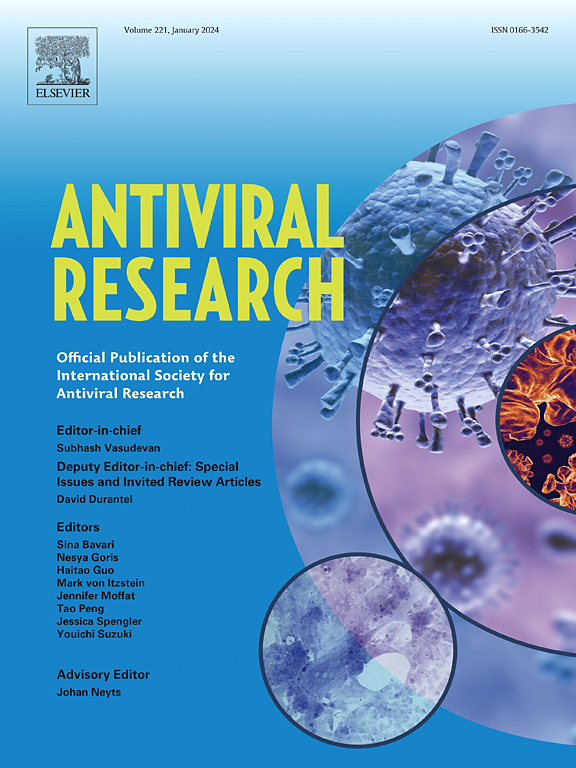Tenofovir alafenamide promotes weight gain and impairs fatty acid metabolism-related signaling pathways in visceral fat tissue compared to tenofovir disoproxil fumarate
IF 4.5
2区 医学
Q1 PHARMACOLOGY & PHARMACY
引用次数: 0
Abstract
Modern antiretroviral therapy (ART) is associated with rapid weight gain, which appears to be antiretroviral-specific. Tenofovir is a nucleoside reverse transcriptase inhibitor commonly employed as a backbone in many ART formulations. Tenofovir alafenamide (TAF) has been associated with significant weight gain in people living with HIV (PLWH) initiating ART. Interestingly, tenofovir disoproxil fumarate (TDF), has no impact on weight or may even be weight suppressive. The current study compared the impact of two tenofovir-based ART formulations on weight and adipose tissue. We utilized a humanized mouse model of HIV-infection and administered two clinically relevant ART combinations TAF/dolutegravir (DTG)/emtricitabine (FTC) and TDF/DTG/FTC. As expected, female mice treated with TAF/DTG/FTC had the greatest weight gain and fat accumulation, as measured by dual energy x-ray absorptiometry (DXA). As ART-induced accumulation of visceral adipose tissue is linked to mortality, we isolated visceral adipose tissue for targeted (qPCR) and non-targeted (RNAseq) gene expression. Mice treated with TAF/DTG/FTC had increased expression of adipocyte differentiation related genes, leptin and PPAR-γ. RNAseq revealed that while the expression patterns for both TAF/DTG/FTC and TDF/DTG/FTC treated mice were similar, there were key differences. Specifically, KEGG pathway analysis indicated that TAF/DTG/FTC treated mice showed suppression of multiple fatty acid metabolism related pathways, while TDF/DTG/FTC treated mice showed evidence for increased thermogenesis. The results suggest that weight gain associated with TAF-based ART may be due to impaired adipocyte mediated lipid handling, while suppressed weight gain with TDF-based ART may be secondary to increased browning of visceral adipocytes, although independent validation is necessary.
与富马酸替诺福韦二氧吡酯相比,替诺福韦阿拉那胺促进体重增加并损害内脏脂肪组织中脂肪酸代谢相关的信号通路
现代抗逆转录病毒治疗(ART)与体重迅速增加有关,这似乎是抗逆转录病毒特异性的。替诺福韦是一种核苷类逆转录酶抑制剂,通常在许多抗逆转录病毒制剂中用作主干。替诺福韦阿拉芬胺(TAF)与开始抗逆转录病毒治疗的艾滋病毒感染者(PLWH)体重显著增加有关。有趣的是,富马酸替诺福韦二吡酯(TDF)对体重没有影响,甚至可能抑制体重。目前的研究比较了两种基于替诺福韦的ART制剂对体重和脂肪组织的影响。我们使用人源化的hiv感染小鼠模型,并给予TAF/多替格拉韦(DTG)/恩曲他滨(FTC)和TDF/多替格拉韦/FTC两种临床相关的抗逆转录病毒治疗组合。正如预期的那样,通过双能x射线吸收仪(DXA)测量,TAF/DTG/FTC处理的雌性小鼠体重增加和脂肪积累最大。由于art诱导的内脏脂肪组织积累与死亡率有关,我们分离了内脏脂肪组织进行靶向(qPCR)和非靶向(RNAseq)基因表达。TAF/DTG/FTC处理小鼠脂肪细胞分化相关基因、瘦素和PPAR-γ的表达增加。RNAseq显示,虽然TAF/DTG/FTC和TDF/DTG/FTC处理小鼠的表达模式相似,但存在关键差异。具体来说,KEGG通路分析表明,TAF/DTG/FTC处理的小鼠显示出多种脂肪酸代谢相关通路的抑制,而TDF/DTG/FTC处理的小鼠显示出产热增加的证据。结果表明,与tdf为基础的ART相关的体重增加可能是由于脂肪细胞介导的脂质处理受损,而tdf为基础的ART抑制体重增加可能继发于内脏脂肪细胞褐变增加,尽管需要独立验证。
本文章由计算机程序翻译,如有差异,请以英文原文为准。
求助全文
约1分钟内获得全文
求助全文
来源期刊

Antiviral research
医学-病毒学
CiteScore
17.10
自引率
3.90%
发文量
157
审稿时长
34 days
期刊介绍:
Antiviral Research is a journal that focuses on various aspects of controlling viral infections in both humans and animals. It is a platform for publishing research reports, short communications, review articles, and commentaries. The journal covers a wide range of topics including antiviral drugs, antibodies, and host-response modifiers. These topics encompass their synthesis, in vitro and in vivo testing, as well as mechanisms of action. Additionally, the journal also publishes studies on the development of new or improved vaccines against viral infections in humans. It delves into assessing the safety of drugs and vaccines, tracking the evolution of drug or vaccine-resistant viruses, and developing effective countermeasures. Another area of interest includes the identification and validation of new drug targets. The journal further explores laboratory animal models of viral diseases, investigates the pathogenesis of viral diseases, and examines the mechanisms by which viruses avoid host immune responses.
 求助内容:
求助内容: 应助结果提醒方式:
应助结果提醒方式:


